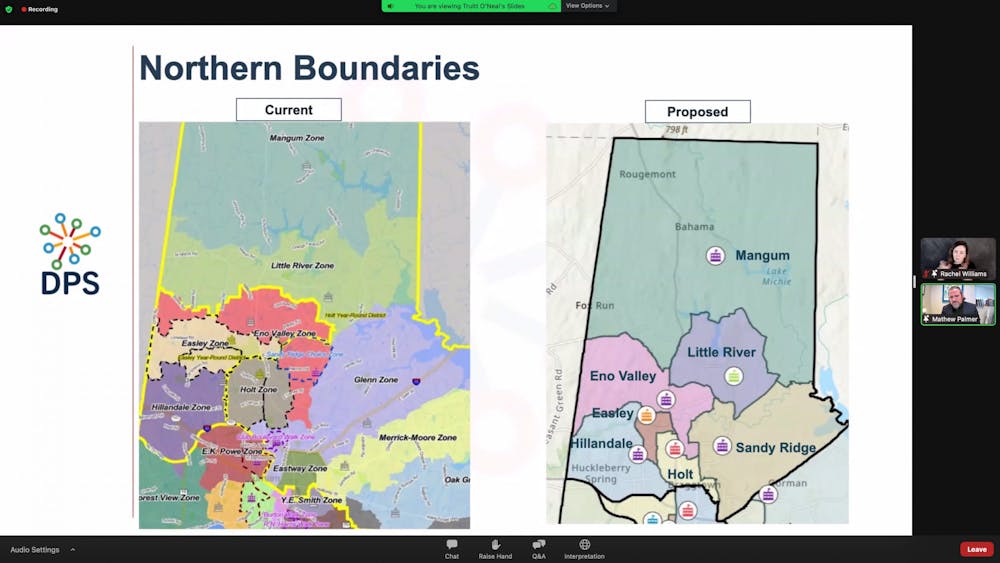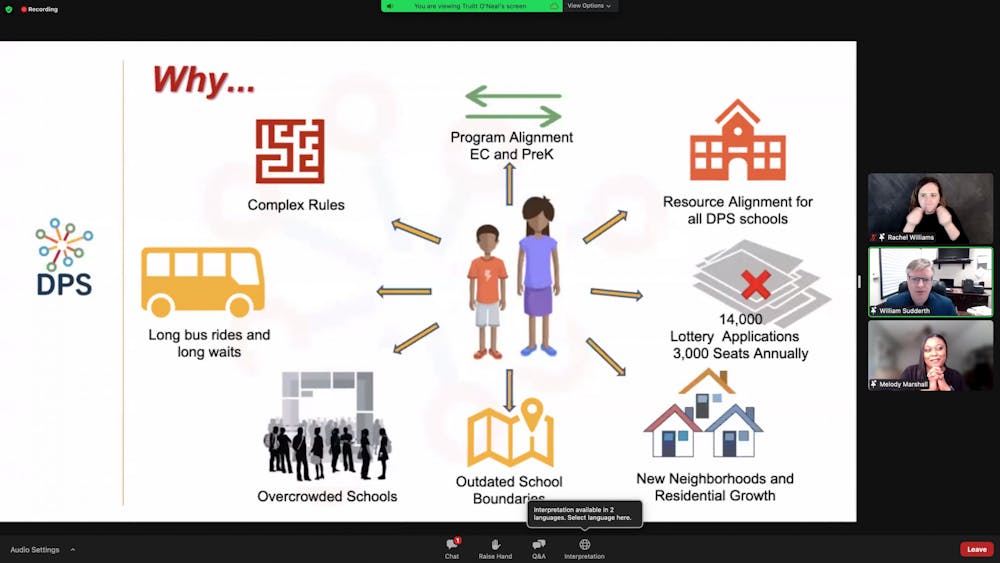Durham Public Schools’ leaders summarized the Growing Together initiative, a new program seeking to reimagine student assignment practices, during their virtual town hall on Thursday evening.
For more than two years, DPS leaders have been engaging with schools, families, educators and stakeholders in the Growing Together initiative, which aims to “increase equity, access, and diversity across [the Durham] school district,” according to the initiative’s website. This work will be completed at the elementary level in the 2024-2025 school year.
The initiative is focused on three goals—aligning preschool and Exceptional Children Special Program classrooms so that the youngest students have access to programs that they need, evaluating the impact and equity of magnet programs and adjusting school boundaries in response to Durham’s rapidly growing community.
Director of Student Assignment Melody Marshall explained the issues that DPS faces today: program misalignment when students transition from one school to another, difficulty in allocating resources for building new schools and outdated school boundaries.
“These are the challenges that we sought to address when we began this journey two years ago,” Marshall said.
Chief Communications Officer William Sudderth said the existing system of student assignment “reflects decades of prioritizing some neighborhoods and some students over others.”
“That was a moment where we as a community must ask, ‘Does this current system reflect our true values? Or does this system reflect a different time and different place?’” Sudderth said.
In light of these school assignment issues, the Growing Together initiative proposed a regional access model where Durham County will be divided into five regions: Southern, Eastern, Central, Southeast and Southwest.
“These regions are bound by geographical and community features as well as infrastructure. Each region is comparable in terms of socioeconomic status and the proportion of families identifying as people of color,” the Growing Together webpage read.
“We're trying to make sure that the schools that we have within Durham are working together to support our community and support our students, and that they don't have to go far to receive the academic instruction and programs they need,” Sudderth said.
Mathew Palmer, executive director for school planning, transportation and nutrition, reviewed Durham’s current school boundaries. DPS has 31 elementary schools slated to support students in the 2022-2023 academic year. Of these 31 schools, there are 22 base elementary school boundaries and 10 choice zones that sit right on top of those boundaries, Palmer said.
“What that's led to is significant disparities at a school level of our frame renewed reduced lunch eligibility rate at a school level—26% at several schools, up to 100% in other schools,” Palmer said.
Palmer then compared current boundaries with Growing Together’s proposed ones. For example, in the proposed Northern region, every elementary school has a base area and a school boundary associated with it, unlike the current region.

In addition, there are a reserved number of lottery seats at schools requiring applications. With the proposed boundaries, Palmer estimates that the lottery seat share will increase from 28% to 51%, and academic programs across DPS will be more equitable and accessible.
“We can ensure when we run the lottery, we balance out the demographics of the school in relation to the base area and the lottery seats,” Palmer said.
According to Palmer, DPS currently has 13 severely over-enrolled or under-enrolled schools. The proposed boundaries will ensure that schools are located in the regions of the children that they serve.
“That’ll shorten those ride times not only for the vehicle miles that we have to travel, but the amount of time that our children have to spend on the school bus,” Palmer said.
DPS Assistant Superintendent Debbie Pittman summarized the academic areas each elementary school is planned to contain by the 2024-2025 school year. Science, technology, engineering and mathematics will be offered daily, and visual arts, music and global languages will be offered weekly.
Get The Chronicle straight to your inbox
Sign up for our weekly newsletter. Cancel at any time.
The plan will also allow district-wide families to apply for Montessori and International Baccalaureate programs. In addition, application year-round schools and Dual Language Immersion programs will be included in each of the five regions, according to Julie Pack, executive director of career and technical education and magnet programs.
Lastly, Pittman explained Growing Together’s plan for the next four years. In the 2022-2023 school year, the new boundaries will go in effect for Lyons Farm, Parkwood and Creekside. Beginning January 2024, new elementary lottery rules will go into effect for the 2024-2025 school year using the regional access model. In the 2024-2025 school year, new school boundaries will go into effect, and in the 2025-2026 school year, six elementary schools will have completed renovations.
In the question and answer section of the panel, Sudderth said addressing school assignments with middle and high schools is the “next step.”
“We need to be just as thoughtful about what we're doing for our middle and high school students as we are for elementary students now,” he said. “They're bigger, we have fewer of them, and we can't exactly move all of our schools all at once to different parts of the community.”
Sudderth also reminded the audience that the Growing Together initiative is not an overnight change.
“A, this is a proposal, and B, this is phased over multiple years,” he said. “We will phase this in gradually so that our community can move forward together and grow together into a more equitable approach to student assignment.”

Katie Tan is a Trinity senior and digital strategy director of The Chronicle's 119th volume. She was previously managing editor for Volume 118.

